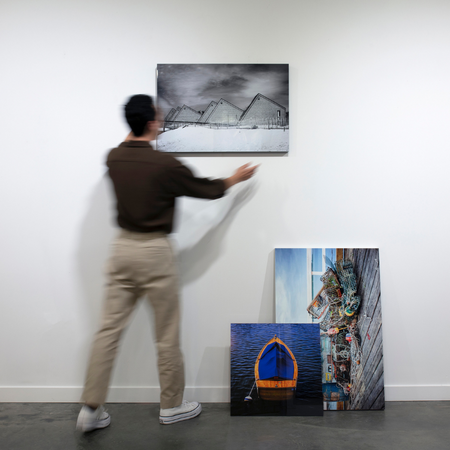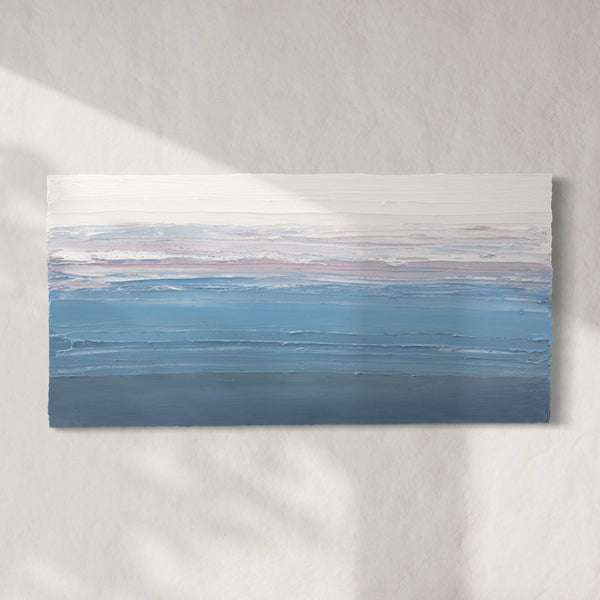If you've looked at photography in the past, you might have noticed the vast number of different ways a photograph can be printed. But, the different options like acrylic, aluminum, canvas, or even different types of paper can often sound like another language (pro tip: sometimes they are), which means simply buying a photograph you love can become a little overwhelming.
We've broken down the different options when customizing our fine art prints (paper or canvas), and you can read more about those on our Prints Explained page. Photography pieces are a little different, however, in that each of our photographers selects the mount options that suits their work best. This helps us maintain excellent quality, but does that make things less confusing? No. That's why we're here to outline the different types of photograph print and mount terms you might see when browsing our Fine Art Photography Collection.
Acrylic/Plexiglass
An acrylic print is made by printing a photograph on a high-quality photo paper, which is then pressure bonded to two sheets of acrylic, usually with a float mount on the back. Because of the float mount, no bolts are visible in the corners.
Acrylic prints are an excellent choice if you're looking for a very modern aesthetic, as they are very clear, with clean edges and no frame. They're also highly durable and waterproof, so they'll hold up in higher-traffic areas. However, acrylic prints will have some glare. This doesn't bother everyone, but if it is something you want to avoid, you'll want to keep it in mind when placing an acrylic print in your space. They can also sometimes be more expensive due to their weight.
Plexiglass is another term used to describe the same mount and finish as an Acrylic print. Acrylic is an abbreviation for the chemical used to create plexiglass, and plexiglass has become the generic term for this type of plastic, which is also referred to by its trademarked name, Plexiglas.
 Acrylic float mount print by Peter Mendelson.
Acrylic float mount print by Peter Mendelson.
Metal
While acrylic prints are printed on paper and then adhered to an acrylic sheet, metal prints differ in that they go through a process called dye sublimation, which allows the metal to absorb the ink directly. Because of this process, which infuses the color into the coating of the metal rather than placing it on the surface, a metal print is highly durable, scratch-resistant, and won't fade. Photography that works best on metal are those that are highly detailed, and that feature bright colors. Like acrylic, they tend to have a more modern aesthetic.
Some artists offer metal prints with a frame that is mounted flush to the edges of the image while others offer their prints on a thinner metal sheet with a float mount (this has a similar look to the acrylic mount above).

Metal sublimation prints by Peter Mendelson with flush mount frame.
You may also see metal print options listed as, "Aluminum," or "Metal Sublimation."
Framed (White)
Framed photographs are printed on paper (generally the paper of the photographer's choosing), and framed under Museum glass or Plexiglass. While framed photographs tend to look great in a more traditional space, they can also fit in a modern space because box frames are simple and sleek. The frame will also add a few inches to the overall dimensions of the piece, so they take up slightly more space than the listed dimensions.
Alyssa Fortin's limited edition photographs are available with the option to frame in a white box frame - you can shop her collection here.

Unframed Print on Paper
Finally, some Sorelle photographers offer unframed prints on paper. Unframed prints are typically shipped rolled in a tube, unless noted otherwise. This is an excellent option if you would prefer more framing options than the photographer offers, so that you can have it framed by a local framer. It is also more economical, as it tends to be the cheapest option to produce and ship.
If you are interested in purchasing an unframed (print only) photograph and that option is not listed, please contact us. We are able to provide a quote for an unframed print on any photography piece.
Photography finishes can seem daunting, but there is not one that is truly better than another. The main thing to consider when selecting your photograph mount is placement, as well as your own budget and visual preference.
For additional information on print and frame options, you can learn more about artwork by Peter Mendelson here and by Alyssa Fortin here, on each of their individual Photography Explained pages.
To browse all photography, visit the Photography Collection. Questions? Contact us here or email us at info@sorellegallery.com for additional information.




0 comments
Post a comment